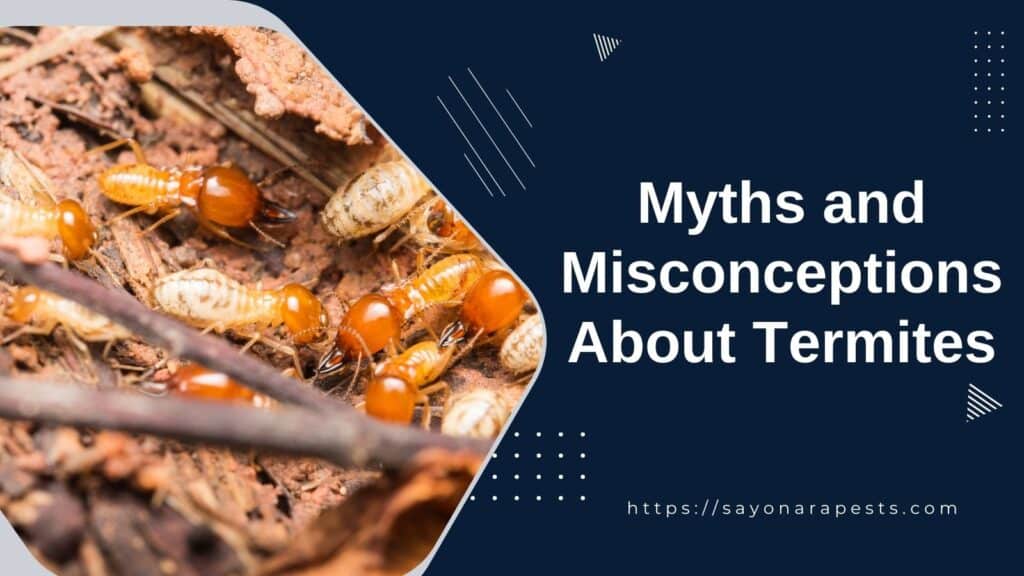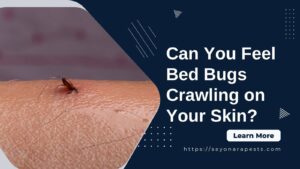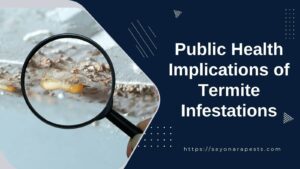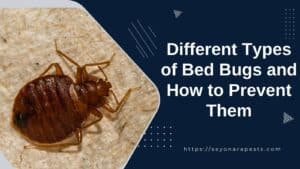Termites are a pervasive pest that causes billions of dollars of damage each year worldwide. These tiny insects may seem harmless at first glance, but they have the ability to wreak havoc on homes and buildings.
Unfortunately, there are many myths about termites that can lead to improper treatment or prevention methods. In this article, we will delve into the 15 most common myths and misconceptions about termites, providing accurate information to help you better understand these destructive pests.
The purpose of this outline is to provide a comprehensive guide to dispelling common misconceptions about termites. By understanding the truth about these pests, you will be better equipped to take proactive measures to prevent and treat termite infestations.
Whether you are a homeowner, a business owner, or simply someone who is interested in learning more about termites, this outline will provide you with valuable insights and information.
Understanding details about termites is essential for effective termite control and prevention. For example, if you believe that termites only infest wooden structures, you may not take proper precautions to protect other types of materials, such as concrete or brick.
Similarly, if you believe that termites are only active in the spring and summer, you may not be aware of the potential for year-round infestations. By dispelling these and other myths, you will be better prepared to prevent and treat termite infestations in your home or business.
Myth #1: Termites only infest old and poorly maintained homes
One of the most common myths is that termites only infest old and poorly maintained homes has persisted for decades. This misconception likely stems from the idea that older homes are more vulnerable to termite damage due to their weaker foundations and outdated building materials.
Additionally, many people assume that homes that are not well-maintained or have visible damage are more likely to attract termites.
However, this myth couldn’t be further from the truth. The fact is that termites can infest any home, regardless of its age or level of maintenance. Termites are attracted to homes for a variety of reasons, and their presence is often unrelated to the age or upkeep of the property.
One of the main factors that attract termites to homes is moisture. Termites need a constant source of moisture to survive, and they will seek out damp areas in and around a home.
This could be anything from leaky pipes and faulty gutters to standing water in a basement or crawl space.
Another factor that can attract termites to a home is the presence of wood. Termites feed on cellulose, which is found in wood, paper, and other plant-based materials.
This means that any home with wooden structures or furniture is at risk of a termite infestation.
Additionally, termites are attracted to warmth and darkness, which is why they often infest basements, crawl spaces, and other dark, humid areas of a home. They are also attracted to areas with easy access, such as cracks in the foundation or gaps around windows and doors.
The myth that termites only infest old and poorly maintained homes is simply not true. Termites can infest any home, regardless of its age or level of upkeep.
Myth #2: Termites can be controlled with DIY methods
Another myth about termites is that they can be effectively controlled with do-it-yourself (DIY) methods.
Many people believe that they can purchase over-the-counter termite control products or use household items to get rid of termite infestations on their own, without the help of professional exterminators.
This myth has persisted for years, despite the fact that termites are some of the most destructive pests that can invade a home.
The truth is that controlling a termite infestation requires professional expertise and specialized equipment. While DIY methods may seem like a cost-effective solution in the short term, they can often end up costing homeowners much more in the long run.
In many cases, DIY methods only serve to mask the problem temporarily, allowing termites to continue to wreak havoc on a home’s structure and cause significant damage.
Professional exterminators have access to the latest technologies and treatment methods, which are specifically designed to eradicate termite infestations and prevent their return. They are trained to identify the signs of a termite infestation, such as mud tubes, frass, and termite wings, and to develop a targeted treatment plan that will effectively eliminate the colony.
Additionally, professional exterminators have the knowledge and experience to determine the most appropriate type of treatment for the specific type of termite infestation, whether it be subterranean termites, drywood termites, or dampwood termites.
Attempting to control a termite infestation with DIY methods can be incredibly risky, both in terms of the potential for further damage to a home and the health risks associated with some DIY termite control products.
Many over-the-counter termite control products contain harsh chemicals that can be harmful to humans and pets if not used properly. In addition, using DIY methods can often lead to incomplete or ineffective treatment, which can allow the termite colony to continue to grow and cause more damage to a home’s structure.
Another risk of DIY termite control methods is that homeowners may not be able to accurately identify the extent of the termite infestation.
Termites can be difficult to detect, and without the proper training and equipment, homeowners may not be able to identify all of the areas where termites are present. This can lead to incomplete treatment and further damage to a home.
While the myth that termites can be controlled with DIY methods may be tempting to believe, the truth is that professional termite control is the safest and most effective way to eliminate a termite infestation and prevent further damage to a home’s structure.
Attempting to control a termite infestation on your own can be risky and costly, and may ultimately lead to more problems in the long run. Homeowners who suspect that they have a termite infestation should contact a professional exterminator immediately to schedule a thorough inspection and develop a targeted treatment plan.
Myth #3: Termites only infest wooden structures
One common misconception about termites is that they exclusively infest wooden structures. This myth stems from the fact that termites are well-known for their ability to cause significant damage to wooden buildings, furniture, and other wooden items.
As a result, many people assume that termites have a preference for wood and are not a threat to structures made from other materials. However, this belief is not entirely accurate and fails to capture the full scope of termite behavior.
Termites are not limited to only wooden structures. While it is true that certain termite species, such as subterranean and Drywood Termites, primarily target wood, they are not the only types of termites in existence. There are over 2,700 species of termites worldwide, and they exhibit a wide range of behaviors and preferences when it comes to food sources.
Subterranean termites, for example, build their colonies underground and construct mud tubes to access above-ground food sources, which can include not only wood but also other organic matter like plant debris, paper, and cardboard.
These termites are particularly notorious for their ability to cause extensive damage to structures, including homes, by attacking wooden foundations, beams, and even insulation.
Drywood Termites, on the other hand, infest drywood and do not require contact with soil. They are known to infest furniture, wooden floors, doors, and other wooden fixtures. However, it’s important to note that Drywood Termites are not the only type of termite that can damage non-wooden structures.
Termites can infest various materials besides wood, depending on the species and their specific preferences. For instance, termites have been found to attack materials like plastic, rubber, foam insulation, and even certain metals.
This ability to damage non-wooden structures highlights the adaptability and resourcefulness of termites as they seek out sources of cellulose and other nutrients necessary for their survival.
In fact, some termite species have been known to exploit the weaknesses in construction materials like plaster, concrete, and bricks.
They can use cracks, gaps, or voids in these materials to create tunnels and establish colonies within the structural components of buildings. This behavior can lead to significant structural damage over time, even in structures primarily composed of non-wooden materials.
It’s worth noting that while termites can infest various materials, their impact on non-wooden structures is generally less common and less severe compared to their effects on wood.
However, this does not mean that non-wooden structures are entirely immune to termite infestations. Vigilance and proper preventive measures are still essential to protect against these destructive pests.
The myth that termites only infest wooden structures is far from the truth. While termites are indeed a significant threat to wooden buildings and furniture, they can also infest and damage structures made from other materials.
Myth #4: Termites are not harmful to humans
There is a common misconception that termites are harmless to humans and pose no significant threat to our health. This myth is rooted in the fact that termites primarily feed on wood and cellulose materials, which are not harmful to humans directly.
However, this belief is only partially true, as termites can cause significant damage to the structural integrity of buildings and homes, leading to potentially dangerous situations.
Termites are known to cause significant damage to wooden structures, including buildings, homes, and furniture. They can weaken the wood and make it brittle, increasing the risk of collapse or damage.
This can pose a serious threat to human safety, particularly in the case of large buildings, bridges, and other structures that require a high level of stability. Additionally, termites can damage electrical wiring, which can cause fires and other hazards.
While termites may not directly harm humans, their infestations can have health implications. Termites create and spread dust and debris as they tunnel through wood, which can irritate the eyes and respiratory system.
This can lead to respiratory problems, particularly in individuals with pre-existing conditions such as asthma or allergies. Additionally, the presence of termites can attract other pests such as rodents, which can carry diseases that can be transmitted to humans.
While the myth that termites are not harmful to humans may seem true on the surface, it is essential to recognize the significant damage they can cause to structures and the potential health risks associated with their infestations.
Myth #5: Termites can be eradicated completely
Unfortunately, the idea that termites can be eradicated entirely is nothing more than a myth.
The myth that termites can be eradicated completely is based on the mistaken belief that there is a single “magic bullet” solution that can wipe out entire termite colonies. In reality, however, termites are incredibly resilient creatures that have evolved to survive in a variety of environments.
This means that no single strategy or technique is guaranteed to eliminate all of the termites in a given area.
So, what is the truth about termite elimination? The reality is that while it may not be possible to completely eradicate termites, it is possible to manage termite infestations and minimize the damage they can cause.
This involves taking a multi-faceted approach that incorporates a range of different strategies and techniques.
One key strategy for managing termite infestations is to focus on prevention. This means taking steps to eliminate conditions that are conducive to termite activity, such as reducing moisture levels and sealing up cracks and crevices in your home’s foundation.
By making it more difficult for termites to establish a colony in the first place, you can minimize the risk of serious damage occurring.
Another important strategy for managing termite infestations is to use a combination of physical and chemical treatments. This may involve using baits, traps, or other methods to physically remove termites from your property.
It may also involve using chemical treatments to create a barrier around your home that termites cannot penetrate.
Ultimately, the key to managing termite infestations is to work with a qualified pest control professional who can help you develop a customized strategy based on your unique situation.
With the right approach, it is possible to minimize the impact of termites on your home and property, even if it is not possible to eradicate them entirely.
Myth #6: Termites are only active during certain times of the year
This myth may have arisen due to the fact that termites are more visible during certain times of the year, leading people to assume that they are only active during those times. However, the truth is that termites are active year-round, and homeowners must remain vigilant in their efforts to prevent infestations.
Termites are highly social insects that live in large colonies. These colonies can range in size from a few hundred to several million individuals. Unlike many other insects, termites do not hibernate during the winter months.
Instead, they remain active throughout the year, continuing to feed on wood and other cellulose-based materials. In fact, termites are often more active during the cooler months of the year, as they seek out warm and moist areas to build their colonies.
While termites are active year-round, their behavior can be affected by seasonal changes. For example, during the summer months, termites are more likely to swarm, as this is the time of year when they mate and establish new colonies.
Additionally, during periods of heavy rain or flooding, termites may be forced to abandon their colonies and seek out new sources of food and shelter. This can lead to an increase in termite activity in areas that are not typically affected by infestations.
Overall, it is important for homeowners to understand that termites are active year-round and that preventative measures should be taken at all times.
Myth #7: Termite inspections are unnecessary unless there are visible signs of infestation
One of the most common misconceptions about termites is that homeowners only need to worry about them if they see visible signs of infestation. Unfortunately, this myth can lead to costly and extensive damage to your property. Many people assume that if they don’t see any signs of termites, they don’t have a problem. However, termites are notoriously elusive and can cause significant damage before any visible evidence appears.
Regular termite inspections are crucial for protecting your property from termite damage. These inspections can help identify early signs of termite activity, allowing homeowners to take action before the problem becomes severe.
Professional termite inspections should be conducted at least once a year, and more frequently in areas with high termite activity.
During a termite inspection, a trained professional will examine your property for signs of termite activity, including mud tubes, damaged wood, and swarming termites. If evidence of termites is found, the inspector will recommend an appropriate treatment plan to eliminate the infestation and prevent future damage.
Termite inspections are critical for protecting your property from costly termite damage. Don’t fall for the myth that termite inspections are unnecessary unless there are visible signs of infestation.
Regular inspections can help identify early signs of termite activity, allowing homeowners to take action before the problem becomes severe. Be aware of the signs of termite activity, and schedule a professional inspection at least once a year to protect your property from these destructive pests.
Myth #8: Termite swarms only occur in spring
One common misconception about these insects is that termite swarms only occur in the spring.
This myth has been perpetuated for years, leading many homeowners to believe that they only need to worry about termite infestations during the spring months.
In reality, termite swarms can occur at any time of the year, depending on a variety of factors. Swarming is a behavior that occurs when a colony of termites reaches a certain size and maturity level. At this point, winged termites called alates are produced.
These alates then leave the colony in search of a new location to start a new colony.
Termite swarming behavior is influenced by a variety of factors, including temperature, humidity, and even the time of day. While swarming can be more common during the spring months, it is by no means limited to this time of year.
In fact, termite swarms have been known to occur in the fall and winter months as well.
The timing and frequency of termite swarms can be influenced by a variety of environmental and biological factors. For example, warmer temperatures and higher humidity levels can increase the likelihood of swarming behavior.
Conversely, dry conditions may reduce the frequency of termite swarms.
Other factors that can influence termite swarming behavior include the age of the colony, the presence of predators, and the availability of food and shelter. As a colony grows and matures, it becomes more likely to produce alates and engage in swarming behavior.
Ultimately, it is important for homeowners to understand that termite swarms can occur at any time of year and to take steps to prevent termite infestations year-round.
Myth #9: Termite damage is always visible
There is a common myth that termite damage is always visible. However, this is simply not true. Termites are notorious for their ability to remain hidden and cause damage to structures without being noticed.
The myth likely stems from the fact that in many cases, visible signs of termite damage are apparent, such as hollowed-out wood or small holes in walls or furniture. However, it is important to understand that these visible signs are often only the tip of the iceberg, and much more damage may be occurring below the surface.
Termite damage can often go unnoticed for extended periods of time, leading to extensive structural damage and costly repairs. Termites are small and difficult to spot, and they often enter homes through hidden entry points, such as cracks in the foundation or gaps in siding.
Once inside, they begin to feed on the wood and other cellulose-based materials, often working their way through walls and floors without leaving any visible signs of damage. This can result in weakened structures that are at risk of collapse, posing a serious safety hazard to occupants.
There are several methods for detecting termite damage that is not visible to the naked eye. One of the most effective ways is to have regular professional termite inspections conducted.
These inspections utilize specialized equipment, such as moisture meters and thermal imaging cameras, to detect signs of termite activity that may be hidden from view.
Additionally, homeowners can take proactive measures to prevent termite infestations, such as keeping wood and other cellulose-based materials away from the foundation of the home, fixing any leaks or moisture issues that may attract termites, and sealing any cracks or gaps in the siding or foundation that could serve as entry points for termites.
Myth #10: Chemical treatments are the only way to control termites
The myth that chemical treatments are the only way to control termites has been around for quite some time. It stems from the idea that termites are incredibly resilient pests that can only be eradicated through the use of harsh chemicals.
While it is true that termites are formidable foes, the notion that chemical treatments are the only solution is simply not accurate.
In reality, there are several alternative termite control methods that are just as effective as chemical treatments, if not more so. One popular method is the use of physical barriers, such as stainless steel mesh or crushed rock, to prevent termites from accessing a building’s foundation.
Another effective approach is the use of bait stations, which lure termites away from a structure and into traps that contain a slow-acting poison.
Another effective method is the use of heat treatments, which involves raising the temperature inside a building to a level that is lethal to termites.
This method is particularly effective for treating large infestations, as it can reach areas that are difficult to access with traditional chemical treatments.
While chemical treatments have long been the go-to solution for termite control, they do have their drawbacks. One of the main disadvantages is that they can be harmful to the environment and pose a risk to human health.
Additionally, some termites have developed resistance to certain chemicals, which can render them ineffective.
Non-chemical treatments, on the other hand, are generally safer for both humans and the environment. They also tend to be more targeted, as they can be used to treat specific areas of a building rather than saturating the entire structure with chemicals.
However, non-chemical treatments can sometimes be less effective than chemical treatments, particularly in cases of severe infestations.
Ultimately, the choice between chemical and non-chemical termite control methods will depend on a variety of factors, including the severity of the infestation, the location of the structure, and the preferences of the property owner.
In some cases, a combination of both chemical and non-chemical methods may be the most effective solution. Regardless of the approach taken, it is important to work with a reputable pest control professional to ensure that the infestation is dealt with safely and effectively.
Myth #11: Termites are only found in certain regions
Termites, those tiny wood-munching creatures that scuttle and swarm in dark corners, have long been subject to a pernicious myth that suggests they only exist in certain regions.
This false idea is based on the notion that termites are ultra-specialized critters that require highly specific environmental conditions to survive. However, this is unequivocally untrue.
In reality, termites are distributed throughout the world with the sole exception of Antarctica. Whilst certain termite species may be more prevalent in certain geographical zones, it’s a gross error to assume that they are only restricted to those areas.
In fact, termites are known to thrive in a vast array of environments, from parched deserts to lush rainforests, and from grassy meadows to bustling urban centers. What’s more, termites are remarkably adaptable creatures, capable of coping with ever-changing environmental conditions and expanding their range to colonize new regions.
Numerous factors play a part in termite distribution and range expansion. Perhaps the most significant of these is temperature, which can significantly affect termite survival rates and their breeding habits.
Warm, humid conditions are typically required for termites to thrive, which is why they are often found in tropical and subtropical regions. However, certain termite species can also survive in cooler environments.
Another crucial factor that determines termite distribution and range expansion is food availability. Termites feed primarily on dead plant material, wood, and other organic matter, so they require a steady supply of these resources to survive.
As a result, termites tend to thrive in areas with abundant plant life, such as forests and grasslands.
Human activity also plays a significant role in termite distribution and range expansion. The ever-increasing pace of urbanization and deforestation can dramatically alter termite habitats and force them to relocate.
Furthermore, the transport of infested wood products can facilitate the spread of termites to new areas, thereby enabling them to expand their range even further.
Despite certain species being more prevalent in particular regions, termites have repeatedly shown their ability to adapt to new conditions and expand their range, making them a ubiquitous and formidable pest in many parts of the world.
Myth #12: Termite infestations always start outside the home
Termites are notorious for their ability to cause significant damage to homes and other structures, and as such, many people are understandably concerned about the possibility of a termite infestation.
However, there are many misconceptions about termites and how they operate, and one of the most common myths is that termite infestations always start outside the home.
The reality is that termites can enter a home in a variety of ways, and infestations can originate from a number of sources. While it is true that termites often enter a home from the outside, such as through cracks in the foundation or gaps in the siding, they can also enter through other means.
For example, termites may enter a home through a tree that is in contact with the structure, or through a pipe or other conduit that leads into the home.
Another important factor to consider is that termites do not necessarily need to have a direct entry point into the home in order to cause an infestation.
They are capable of building mud tubes or other structures that allow them to traverse across or through obstacles, such as concrete slabs or brick walls.
This means that even if a home appears to be well-sealed and protected, there may still be hidden vulnerabilities that termites can exploit.
Some of the most common ways that termites enter and infest homes include:
Cracks and gaps in the foundation: Termites can easily slip through small cracks or gaps in the foundation of a home, and once inside, they can quickly begin to cause damage.
Wood-to-soil contact: When wood comes into direct contact with soil, it can provide a direct entry point for termites. This often occurs when wooden fence posts, decks, or other outdoor structures are installed too close to the home.
Roof leaks: Moisture is a key factor in attracting termites, and roof leaks can create ideal conditions for infestation. Termites may enter through the roof and begin to feed on wooden rafters or other structures.
Firewood storage: Storing firewood against the side of a home can create a direct pathway for termites to enter. It is important to keep firewood stacked away from the house and off the ground.
Plumbing and other entry points: Termites can enter a home through a variety of other entry points, such as cracks in pipes or gaps around utility meters. It is important to seal these entry points to prevent infestation.
While it is true that termites often enter homes from the outside, it is a myth that infestations always start in this way. Termites can enter a home through a variety of means, and it is important to take steps to prevent an infestation from all angles.
Myth #13: Termites can be repelled by certain scents or plants
One of the most persistent myths about termite control is that certain scents or plants can repel termites.
This myth asserts that by planting certain species of plants or using specific essential oils or other fragrances, homeowners can keep termites away from their property.
While it may be true that some scents or plants can repel certain insects, there is no scientific evidence to suggest that any plant or scent is effective in repelling termites. In fact, most natural termite repellents have been shown to be ineffective against these destructive pests.
Termites are highly organized and can quickly adapt to changes in their environment, including the presence of scents or plants. They are more likely to be deterred by physical barriers, such as metal screens or treated wood, than by any natural scent or plant.
Relying on natural repellents to keep termites away can be risky for several reasons. First, it can give homeowners a false sense of security, leading them to neglect more effective termite control measures.
Second, some natural repellents can be harmful to humans or pets, particularly if they are used in large quantities or ingested. Finally, natural repellents may not be effective in all situations, particularly if the termite infestation is severe.
While it may be tempting to rely on natural termite repellents, there is no scientific evidence to suggest that any scent or plant is effective in repelling these destructive pests.
Myth #14: Termite baiting systems are foolproof
Termite baiting systems have gained popularity in recent years as a supposedly foolproof method for controlling termite infestations. The basic premise of these systems is to strategically place bait stations containing a slow-acting toxin that will be carried back to the termite colony, eventually leading to its elimination.
However, this approach is not without its myths and misconceptions, one of which is the belief that termite baiting systems are infallible and will always work to completely eradicate a termite problem.
While termite baiting systems can be effective in many cases, they are not foolproof and there are several limitations to consider. Firstly, they are not an immediate solution to termite infestations.
The process of baiting and colony elimination can take several months or even years to complete, depending on the size of the colony and the severity of the infestation. In addition, baiting systems are not always effective in eliminating entire termite colonies, especially if the colony is large or has multiple satellite nests.
Another limitation of termite baiting systems is that they rely heavily on the behavior of the termites themselves.
For example, if the bait station is not properly placed or is not attractive enough to the termites, they may simply ignore it and continue to feed on the structure. Additionally, there is a risk that the termites may simply move to a different area of the structure, avoiding the bait stations altogether.
There are several types of termite baiting systems available, each with its own set of advantages and disadvantages. One popular type is the in-ground baiting system, which involves placing bait stations in the soil around the structure.
This approach can be effective in attracting termites and eliminating colonies, but it can also be time-consuming and expensive to install.
Another type of termite baiting system is the above-ground system, which involves placing bait stations directly on the structure. This approach can be less invasive and more convenient than in-ground systems, but it may not be as effective in eliminating entire termite colonies.
Some newer termite baiting systems use synthetic pheromones to attract termites to the bait stations. While these systems can be highly effective in attracting termites, they may also be more expensive and require more maintenance than other types of baiting systems.
Ultimately, the effectiveness of termite baiting systems will depend on a variety of factors, including the size and severity of the infestation, the type of system used, and the behavior of the termites themselves.
While they can be an effective tool in controlling termite populations, they are not foolproof and should be used in conjunction with other preventative measures to ensure the long-term health of the structure.
Myth #15: All termite species behave the same way
The myth that all termite species behave the same way is a common misconception that has been perpetuated over time. This myth suggests that all termites have the same biology and behavior and that they all exhibit similar characteristics and habits.
However, this is far from the truth. The reality is that there are numerous species of termites, each with their own unique biology, behavior, and characteristics. The idea that all termites behave the same way is simply untrue.
The reality is that there are over 2,700 known species of termites worldwide, and each species has its own unique biology and behavior. Some termites build their nests underground, while others build their nests above ground.
Some termites feed on wood, while others feed on grass or other plant materials. Some termites live in large colonies, while others are solitary. There is also a wide range of variations in termite behavior, including differences in communication, reproduction, and social organization.
One example of a termite species with unique characteristics is the African termite Macrotermes bellicosus. This species builds enormous nests that can reach up to 30 feet tall and 60 feet wide, and they can contain up to several million individuals.
Another example is the Australian termite Nasutitermes walkeri, which has a unique defense mechanism where soldiers shoot a sticky secretion at predators to immobilize them.
Another fascinating species is the Neotropical termite Nasutitermes corniger. This species has a highly specialized caste of soldiers that have evolved to defend against a specific predator, the arboreal ant, by using their large and sharp mandibles to chop off the legs of the ants.
In contrast, the termite species Coptotermes formosanus is considered a major pest in many parts of the world because of its ability to damage wooden structures.
The idea that all termite species behave the same way is a myth that does not reflect the diverse reality of these fascinating insects.
Each termite species has its own unique biology, behavior, and characteristics, and researchers are constantly discovering new species and learning more about their intricate social systems and interactions with the environment.
Myth #16: Termites Belong to the Ant Family
Another common misconception about termites is that people often think that termites are in the same family as ants. Even though termites and ants are both social insects that live in groups, they are not in the same order as insects.
Ants are in a different order than termites, which are in the order Isoptera. Even though they live in colonies and have a hierarchical social structure, termites and ants are very different in terms of their biology, behavior, and roles in the environment.
Myth #17: Termite Colonies Can Be Killed Through Deforestation
Another common belief is that cutting down trees will get rid of termite colonies. It’s important to remember that termite colonies grow best in wood and soil, not in the trees themselves.
Deforestation may temporarily change the way some termite species live, but it does not mean they will go extinct. Termites are very flexible and can move their colonies to new places that are better for them.
To get rid of termites effectively, you need to use targeted methods that focus on getting rid of existing colonies and stopping new ones from coming in.
Myth #18: Termites Only Exist To Destroy
Many people think that termites only exist to hurt things. Even though termites are known for doing a lot of damage to wooden buildings, we shouldn’t forget how important they are for the environment.
As decomposers, termites are important to ecosystems because they break down dead plants and put nutrients back into the soil. They also help get air into the soil and help make humus, which is good for plant growth.
So, it’s important to realize that termites have a bigger effect on the environment than just being destructive pests.
Myth #19: Termites Can Eat Concrete
People often think that termites can eat through concrete, which is not true. Even though termites can do a lot of damage to wooden structures, the idea that they can get into and eat concrete is not true.
In their digestive systems, termites have enzymes that help them break down cellulose, which is the main part of the wood. On the other hand, termites can’t eat concrete because it is made of cement, small rocks, and water.
But it’s important to remember that termites can use cracks or holes in concrete to get to other materials, like wood, that they can eat more easily.
Myth #20: Termites Will Never Go Back After Professional Treatment
Some people believe in a very common misconception that once termites have been treated by a professional, they will never come back. Professional treatments for termites can be very effective at getting rid of existing colonies, but they don’t guarantee that they won’t come back.
Termites are hardy bugs that can start new nests if the conditions are right. Chemical barriers or bait systems are often used by professionals to keep termites away, but ongoing monitoring and preventive measures are needed to keep termites away for good.
In conclusion, understanding the common myths and misconceptions about termites is crucial for homeowners and property managers alike. It is important to dispel the belief that termites only infest old and poorly maintained homes because termites can infest any structure that provides them with the necessary food, moisture, and shelter.
DIY termite control methods may seem like a cost-effective solution, but they can be ineffective and even harmful to humans and pets. Chemical treatments are not always the only solution, and alternative termite control methods may be more effective and environmentally friendly.
Furthermore, it is essential to recognize that termite activity is not limited to certain times of the year and that termite inspections are necessary even when there are no visible signs of infestation.
Additionally, it is vital to understand that not all termite damage is visible and that hidden termite damage can be just as harmful and costly. While natural termite repellents and baiting systems may seem like a desirable option, they have their limitations and should not be solely relied upon for termite control.
Finally, it is important to acknowledge that not all termite species behave the same way and that different termite species have unique characteristics that must be taken into account when dealing with termite infestations.
By understanding the diversity of termite behavior and biology, property owners and managers can take appropriate measures to prevent and manage termite infestations effectively.
In summary, accurate information about termite behavior and control is essential for preventing and managing termite infestations.
The common myths and misconceptions about termites discussed in this article must be understood and debunked to ensure that homeowners and property managers can take appropriate measures to protect their properties and avoid costly termite damage.
Regular termite inspections, the use of effective termite control methods, and proper maintenance of structures are recommended to prevent and manage termite infestations.










